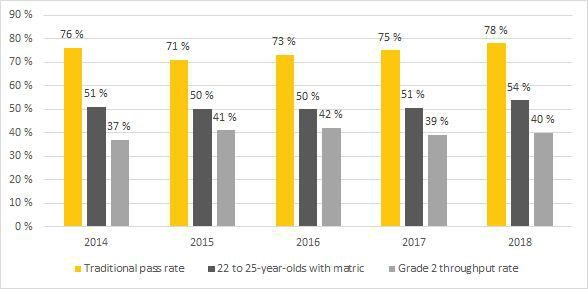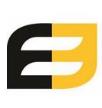Equal Education pre-matric results statement: Potentially drastic education reforms will not curb high dropout rates reflected in matric results
7 January 2020
Equal Education (EE) wishes the Class of 2019 the best for their matric results and applauds the hard work and time invested by learners, teachers, parents and school districts, throughout the years to get to this point.
While the release of the matric results remains a critical moment for hundreds of thousands of learners, these results do not provide a good indication of the health of the education system as a whole. We anticipate that Basic Education Minister Angie Motshekga will today announce an improvement in the overall pass rate, with some speculating that it will breach the 80% mark for the first time.1 “A system on the rise!” the Minister will likely declare again this year.
However, celebrating this pass rate has become almost farcical - every year experts petition Motshekga to place greater emphasis on the percentage of Grade 2 learners who leave school with a matric certificate a decade later.
The difference in pass rates, when dropouts are considered, is striking. The graph below provides a comparison between 1) the traditional pass rate announced annually by Motshekga; 2) figures released by the Department of Basic Education (DBE) that show the percentage of 22 to 25-year-olds who have completed at least Grade 12 or equivalent; 3) the throughput rate, calculated as the percentage of Grade 2 learners who complete their matric ten years later.
Comparison between different methods for calculating the matric pass rate

While we must celebrate the small strides, both the DBE’s own figures and our Grade 2 throughput rate analysis reflect an almost stagnant pass rate rather than overwhelming evidence of a system on the rise.
Streaming learners will not compensate for poor foundation
Two ways in which the DBE is hoping to arrest high dropout rates, is by introducing a standardised national examination at the end of Grade 9, along with a three-stream model that will allow learners to choose between vocational, occupational and academic pathways after Grade 9. The DBE’s rationale seems to be that a standardised General Education Certificate (GEC) will make it easier for learners to transition to other education opportunities such as Technical and Vocational Education and Training (TVET) colleges.3 Furthermore, the DBE argues that technical education streams will ensure that learners who are not “academically inclined”, do not drop out of school.4
While information is scant, these proposals could signal a drastic shift in the basic education landscape. It appears that the academic stream will be the traditional school curriculum that prepares learners for studies at universities. The technical vocational stream will offer a similar curriculum to that offered in existing technical schools, while the technical occupational stream will prepare learners to start working straight after high school.Learners will be either allocated or choose to pursue one of these pathways.5
We recognise the potential value of a “transitional qualification”6 and a basic education system that provides learners with various academic options to choose from. However, EE’s three-stream report highlights a number of concerns that linger around the rationale behind these proposals, including the extent to which they will succeed in lowering dropout rates, and their practical implications. We are concerned that these proposals will further entrench socio-economic inequalities in the education system.
a) Rationale
A major assumption being made, is that learners drop out because the academic focus of the basic education system does not cater to their academic inclination. While this may be true for some learners, it is almost impossible that between 50% and 60% of learners drop out because they are not academically inclined. While there are many factors that contribute to dropouts, we know that the quality of education received in the early years of learning is one critical factor.7
The years from Grade R to Grade 3 are life-altering for learners: it is when the foundation must be laid for learning in all the later grades. The consequence of a weak foundation phase is weak academic outcomes in high school – and the consequence of that is that many learners never reach matric.8
We welcome Motshekga’s acknowledgement that this phase is critical and her plans to address desperately poor literacy through the introduction of initiatives such as a national reading plan for primary schools.9 We wait in anticipation for further details on this plan and to see whether it will include reading coaching for teachers as we have previouslycalled for.
If we do not address the problem of low literacy and numeracy skills in the system, especially in the early years, there is a high risk of streaming learners according to the education opportunities thesystem has afforded them, rather than their academic abilities.
Low completion rates at TVET colleges - which also provide technical and vocational curricula - are a clear indication that simply routing learners into a technical stream will not solve high dropout rates: learners enrolling in TVET colleges struggle to succeed at these institutions, as some do not have the necessary level of foundational skills required. Currently, only around 33% of students at TVET colleges complete their degrees within the minimum time required.10 Learning deficits inherited from earlier education will be obstacles to technical education just as they are to general education, especially where teaching capacity is lacking.11
b) Practicalities of implementation
Furthermore, technical schools could possibly duplicate the role of TVET colleges and even contend with the same challenges confronting the latter, such as a lack of qualified teaching staff with adequateteaching and technical skills. Even before the rollout of this system, Gauteng is currently facing a shortage of teachers for technical schools in the province.14 Training existing teachers to teach occupational and vocational subjects in the three-stream model or recruiting new staff to do so, will undoubtedly be a major challenge.
The DBE has said that its aim is for 14 592 schools - more than half of South Africa’s schools - to be equipped for vocational and occupational streams by 2022,15 yet a recent audit found that there areonly 1 007 technical schools across the country. It is unclear how many new schools will be constructed, how many will be converted, and whether schools will exclusively offer technical streams or offer both academic and technical streams. It remains to be seen how the DBE will ensure thattechnical vocational and occupational schools have access to the necessary equipment, when there are still schools that lack running water and electricity!17
Implementing these policy proposals will no doubt put tremendous pressure on an already shrinkingbasic education budget.As it stands, the TVET sector is also already facing severe financial constraints, resulting in some programmes not allowing increases in student enrolment over the next three years, unless additional budget allocations are provided.18 It’s hard to imagine how an additional technical and vocational system will overcome, rather than exacerbate, these challenges.
Conclusion
Equal Education supports attempts to strengthen and expand occupational and vocational opportunities for learners, but these attempts should be streamlined and must avoid duplication. Alternatives should expand the choices that learners have, without unfairly streaming them into restrictive technical pathways that are likely to disadvantage learners from poor and working class backgrounds.
Instead of treating a symptom - by declaring that learners drop out because they are not academically inclined - the DBE must make every effort to ensure that learners receive quality education in the foundation phase. This will allow them to choose their own academic pathways rather than be forced into one - or out of school entirely - by a failing system.
Issued by Jay-Dee Cyster, Equal Education Communications Officer, 7 January 2019
Masondo, S. “‘The system is on the rise.’ Matric pass rate hits 80%”. City Press.06 January 2020. Available at: https://city-press.news24.com/News/the-system-is-on-the-rise-matric-pass-rate-hits-80-20200105
2 Department of Basic Education, 2019. NSC Examinations 2018: Technical Report. Slide 60. Available at:https://www.education.gov.za/Portals/0/Documents/Reports/NSC%2018%20DG%20Technical%20Report.pdf?ver=2019-01-04-085656-530;Minister Angie Motshekga, 2019. Response to a Parliamentary Question NW1251. 13 November 2019. Available at: https://pmg.org.za/committee-question/12672/;Department of Education, 2005, 2006, 2008, 2009, 2010. Education Statistics in South Africa 2004 and 2005; Education Statistics in South Africa 2006, 2007 and 2008.(own calculations)
Department of Basic Education, 2019. Media Release: “Basic Education Department Briefs Portfolio Committee on theGeneral Education Certificate, 15 October 2019”. Available at: https://www.education.gov.za/Newsroom/MediaReleases/tabid/347/ctl/Details/mid/8128/ItemID/7747/Default.aspx4 Department of Basic Education, 2016. “The Introduction Of A Three Stream Model Into The Basic Education Sector”.Department of Basic Education Presentation to the Dialogue of the Institute for Justice and Reconciliation. 23 February 2016. 5 Allais, S. and Fleisch, B., 2019. “Looking beyond the Grade 9 Certificate debate: The Three Streams”. Daily Maverick. 15October 2019. Available at: https://www.dailymaverick.co.za/article/2019-10-15-looking-beyond-the-grade-9-certificate-debate-the-three-streams/
6 Minister Angie Motshekga, 2019. “Is there hope for basic education”. Sunday Times. 03 November 2019. Available at:https://www.pressreader.com/south-africa/sunday-times-1107/20191103/281865825274232
7 Hartnack, A., 2017. Background document and review of key South African and international literature on school dropout,pg.2. Available at: https://dgmt.co.za/wp-content/uploads/2017/08/School-Dropout-Background-Paper-Final.pdf
8 Equal Education media statement, 2019, p. 1. Arrested development: Matric exams are one step in an uphill education pathfor SA learners. Available at: https://equaleducation.org.za/wp-content/uploads/2019/01/Equal-Education-matric-2019-media-statement-1.pdf
9Angie Motshekga, 2019. “Education is a system on the rise that is beginning to show irreversible gains”. Times Live. 03
November 2019. Available at:
ng-to-show-irreversible-gains/
Department of Higher Education and Training, 2018. 2017/18 Annual Report.Available at:https://www.gov.za/sites/default/files/gcis_document/201810/dhet-annual-report-20172018.pdf
Equal Education, 2016. The Three Stream System Report, p. 14. Available at:https://equaleducation.org.za/wp-content/uploads/2018/05/Three-Stream-Report.pdf
Portfolio Committee on Higher Education and Training, 2017, p. 5. Report of the Portfolio Committee on Higher Education and Training on consideration of Budget Vote 15. 10 May 2017. https://pmg.org.za/committee-meeting/24341/
Allais, S. and Fleisch, B., 2019. “Looking beyond the Grade 9 Certificate debate: The Three Streams”. Daily Maverick. 15 October 2019. Available at: https://www.dailymaverick.co.za/article/2019-10-15-looking-beyond-the-grade-9-certificate-debate-the-three-streams/
Bengtson, A., 2019. “There’s shortage of teachers at Gauteng technical schools”. Sowetan Live. 15 October 2019. Available at: https://www.sowetanlive.co.za/news/south-africa/2019-10-15-theres-shortage-of-teachers-at-gauteng-technical-schools/
Equal Education, 2016. The Three Stream System Report,pg 4. Available at:
https://equaleducation.org.za/wp-content/uploads/2018/05/Three-Stream-Report.pdf
Dr Simelane, M. 2019. Answer to a question from members of the Portfolio Committee on Basic Education after DBE’spresentation on the General Education Certificate. 15 October 2019
Department of Basic Education, 2019. 2019 National Education Infrastructure Management System Report.27 September
2019. Available at: https://www.education.gov.za/Portals/0/Documents/Reports/NEIMS%20standard%20reports%202019.pdf?ver=2019-09-27-150623-250;
Department of Basic Education, 2018. SAFE Presentation. Available at: https://www.education.gov.za/Portals/0/Documents/Publications/SAFE%20Presentation.pdf?ver=2018-08-14-130300-673
Department of Higher Education and Learning. Briefing on the Governance and Management of TVET Colleges. Presentation to the National Assembly Committee on Higher Education, Science and Technology. 12 November 2019. Available at: https://pmg.org.za/committee-meeting/29311/

